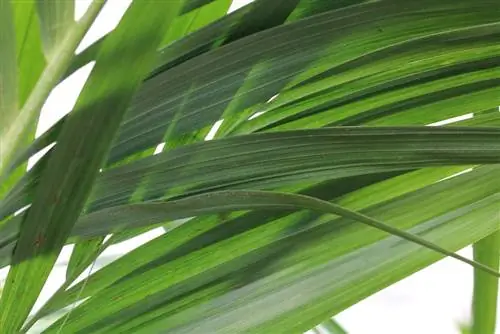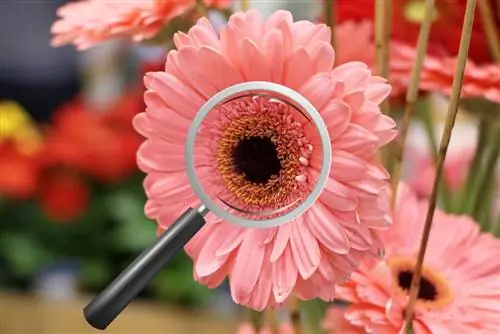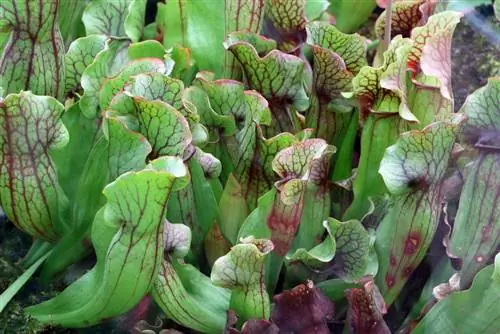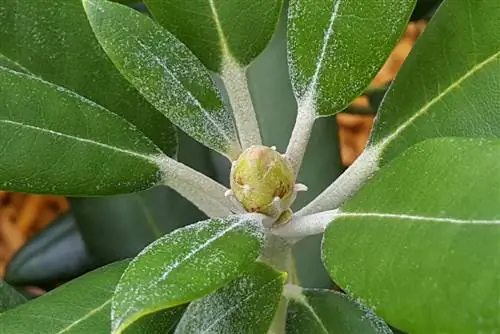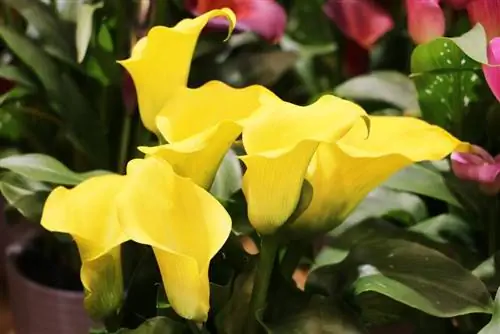- Author admin [email protected].
- Public 2023-12-17 03:39.
- Last modified 2025-01-24 12:45.
Houseplants have been with us humans for quite a long time. While in the Middle Ages it was usually native plants that people brought into their homes, collecting exotic plants became a hobby as early as the 16th century, which only the nobility could afford. Since the end of the 19th century, plants have simply been a fixture as decorative objects in houses and apartments. Nowadays there is an almost endless variety of houseplants. There is something for every taste and for almost every location - regardless of whether you have a green thumb or not.
Top 16 of the most popular green plants for the apartment
It doesn't always have to be flowering houseplants that create a great atmosphere in the room. Green plants can also create an irresistible charm. The attractive foliage of a dragon tree or the bizarre growth habit of a succulent plant such as the elephant's foot are real eye-catchers and fit into any interior style.
It probably doesn't surprise anyone that it is the robust and easy-care plants that are particularly popular as houseplants. These include many exotic plants that have been decorating window sills and hanging baskets for hundreds of years. We have put together the 16 most popular houseplants for you.
Birch fig (Ficus benjamini)
Although the birch fig looks similar to the rubber tree, the main difference in practice is that it requires significantly more care. A birch fig, also known as Benjamin or Ficus benjamini, originally comes from India and usually develops a main trunk with a wide crown. Numerous, tapered waxy leaves grow on the shoots. As the tree gets older, it becomes somewhat bare from the inside, while its branches overhang towards the outside.
Tip:
Birch figs are very sensitive to changes in location and temperature fluctuations. However, if you give the birch fig a partially shaded location in your consistently warm home and water it regularly, you will enjoy the green plant for years.
Bow hemp (Sansevieria)
Another very popular houseplant is the sansevieria, also called bow hemp. It originally comes from warm, tropical areas and therefore loves it warm all year round. The numerous types of bow hemp can be divided into two groups: The first group grows with leaves that are positioned vertically upwards and are usually rounded or oval in cross section. The second group forms individual leaves that grow strictly upwards and arise from a rosette. The Sansevierias get along well with bright, but also quite dark locations and only need a little water occasionally and fertilizer even more rarely. Even plants that have accidentally not been watered for weeks usually survive these problems completely unscathed.
Dieffenbachia (Dieffenbachia)
The Dieffenbachia is one of the best-known houseplants, which is not surprising because the plant, which comes from tropical rainforests, is very easy to care for - even in winter. The Dieffenbachia belongs to the arum family and therefore only produces very inconspicuous flowers. The green plant doesn't need any special flowers, after all, its uniformly shaped leaves, which are either dotted or dashed in shades of white or yellow depending on the variety, are eye-catcher enough. Even beginners can't go wrong with decorative foliage plants.
Dracaena (Dracaena)

If you like lots of beautifully drawn leaves on a plant, the dragon tree is the right choice. There are countless species with very long, narrow or slightly wider and shorter foliage. In a bright location, most species produce bright color lines in white, yellow and various shades of red on the leaves. The dragon tree originally comes from Africa. Actually, it is not really a tree, but rather an asparagus plant that sprouts its leaves like rosettes from a shoot axis. As the older (lower) leaves fall off over time, a tuft of leaves develops on a slightly woody stem that acts like a trunk.
Elephant foot (Beaucarnea recurvata)
The elephant foot, also known as the bottle tree or water palm, belongs to the agave family and originally comes from Mexico. Since there are long dry phases there, the elephant's foot has developed a thick trunk base in which it can store water. The trunk tapers upwards and is adorned with a tuft of long, very narrow leaves. This unusual appearance as well as the problem-free cultivation has won the elephant's foot a lot of friends among houseplant lovers.
Money tree (Crassula ovata or Crassula argentea)
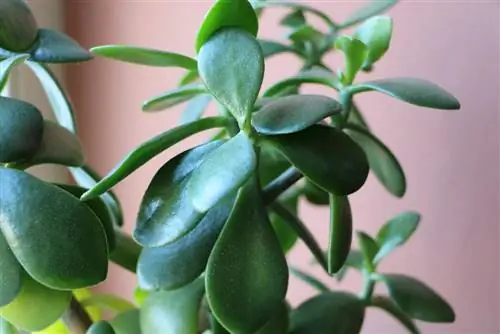
The money tree, also called penny tree or bacon oak, belongs to the thick-leaf family and is native to South Africa. Its most striking feature is its fleshy, round leaves, which are similar in size and shape to a coin. A money tree likes it bright and warm, but it cannot tolerate direct sun. Its leaves quickly burn, turn silvery and fall off. The thick-leaf plant survives with almost no nutrients and thrives in well-drained cactus soil. While it only needs to be watered moderately in the summer months, the money tree needs almost no moisture in the winter.
Green Lily (Chlorophytum)
A particularly vigorous hanging basket plant without great demands is the spider plant, whose pure green or white-striped leaves hang downwards like a crest. Spider plants are represented in our homes and offices with a large number of different varieties. The spider plant likes it bright, including direct sunlight in winter. The warmer and brighter the plant is, the more abundantly it needs to be watered, because the spider plant likes it a little wetter in the summer months.
Rubber tree (Ficus elastica)
Originally native to Asia, the rubber tree with its large, dark green leaves has been decorating our rooms for a long time. With its evergreen leaves, it is an ornament all year round and is considered quite frugal. The popular houseplant loves a bright location and should be exposed to warm temperatures above 18 degrees all year round. If cared for well, the rubber tree grows very old and large, but can be cut without any problems. Although the rubber tree does not have any patterned or colored leaves, it is an experience every time a new leaf grows: Before the deep green leaf unfolds, it first grows into a red stipule that envelops the actual leaf like a bag.
Global thread (Aglaonema)
Many decorative houseplants can be found in the genus Aglaonema, which belongs to the arum family. Most varieties of Aglaonema do not grow taller than one meter and grow very dense and bushy. Their rich green leaves are usually patterned with a grayish or cream color. Although the green plant also produces flowers, these are not particularly noticeable, as is typical for most arum plants. There are also cultivated varieties of the plant, which comes from the Philippines and has a reddish pattern on the edges of the leaves.
Calathea
One of the green plants with the most beautiful leaf markings is the basket marante. This plant occasionally produces flowers, but these are almost lost next to the extravagant leaves. A Calathea only grows to around 40 cm high, but in some varieties their leaves become very long as they age. The markings on the leaves in shades of green, red, brown and silver are very delicate and form completely different patterns depending on the variety. The basket marante originally comes from the tropical Amazon region, where it thrives in the shade of large trees. The plants in the room like it to be partially shaded and warm and humid.
Palm trees
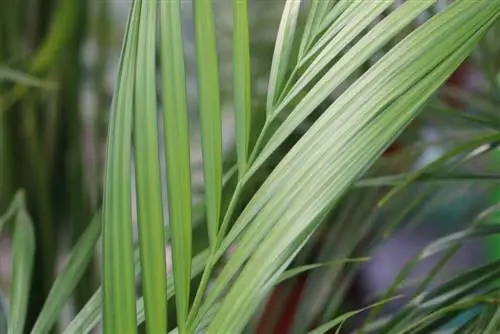
Palm trees are the epitome of a vacation on exotic beaches. This is probably the reason why the plants are among the most popular green plants in our homes. The true palms are divided into two groups: the pinnate palms and the fan palms. But not all green plants that bear the name palm are real palm trees. Many of these plants only have the growth and appearance of a palm tree, but are therefore no less common in our houses and apartments. The most popular palm trees include:
- Mountain palm (Chamaedorea elegans)
- Gold fruit palm (Dypsis lutescens, formerly Chrysalidocarpus lutescens)
- Hemp palm (Trachycarpus)
- Kentia palm (Howea)
- Priest Palm (Washingtonia)
- Hollow palm (Rhapis excelsa)
Philodendron
Most species of Philodendron are climbing plants. In nature, the tree lover, also known as tree lover, usually climbs up other plants such as large trees and develops its characteristic aerial roots. These cling to the bark of the tree and provide the plant with good support. Philodendrons come in different types that have different leaf shapes, but are always thick and leathery. Some species grow with strong vines and have to be attached to a climbing aid, others have a rather bushy growth and can be easily cultivated without a climbing aid.
Radiant Aralia (Schefflera)
In its Asian and Australian homeland, the radiant aralia can grow as large as a tree. The growth of the evergreen plant is limited indoors. Generally it does not grow taller than a shrub. What is characteristic of a Schefflera are its leaves: usually seven green or variegated pointed-oval leaves grow in a radiating shape from a common stem. Specimens on a standard tree or with braided trunks are particularly decorative.
Palm Lily (Yucca)
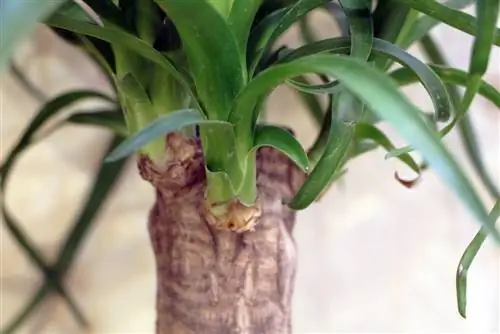
The palm tree that isn't actually a palm tree: the yucca palm. Yucca actually belongs to the asparagus family. It adorns many a home with its attractive, sword-shaped leaves, which grow as a tuft of leaves on a stem-like shoot as it ages. The yucca does not need much care so that it grows he althy and strong well into old age. After all, the green plant is native to Central America, where it has established itself in desert areas under fairly barren conditions. The trunk easily grows up to several meters high, but can be easily cut. The most common houseplant variety is the Yucca elephantipes.
Wonderbush, Croton (Codiaeum veriegatum)
The miracle bush, also called croton or crab flower, is particularly popular as a houseplant because its leaves are extremely decorative. The smooth, leathery foliage shines in the most beautiful autumn colors - in every season. Some species have large, oak-like leaves, while others have more elongated or strap-shaped foliage. There are now countless varieties with a wide variety of patterns. In addition, the plant, which comes from Southeast Asia, has become much less sensitive through targeted crossing, so that the miracle shrub is now one of the easy-care spurge plants for indoor cultivation.
Zamioculas (Zamioculas zamiifolia)
Zamie is a true heroine among green plants. Not only is it robust, it also forgives almost any neglect on the part of the gardener. However, the Zamioculas not only requires a minimum of care, it is also one of the few houseplants that can cope well with shady lighting conditions. Little or irregular watering, dry or rather humid air, light or shade - it doesn't matter, the Zamie will still grow.
The right location
When choosing the right green plant for your home, you come across an almost endless abundance of different plants. But which one is the right one? The most important criterion is the right location. What many hobby gardeners don't know is that the plant itself provides a lot of information about its needs.
- pointed leaves: act like a rain gutter, indicating high amounts of precipitation and/or high humidity
- thin, very delicate leaves: sign of a partially shaded location with high humidity
- large, soft leaves: lots of warmth and water, the blazing sun should be avoided
- leathery, sap-poor leaves (scacia family): a bright place with a few hours of sun a day
- needle-shaped or very fleshy leaves: indicate a sunny, warm location
Tip:
The more colorful the leaves are, the brighter the location must be.
Conclusion
It is usually the exotic plants that bring a very special ambience to our home. Many tropical plants are used to consistently warm temperatures all year round and therefore retain their foliage all year round. Optimal conditions for cultivation in the room. The most popular houseplants include those species that have particularly attractive growth forms, produce patterned or even colorful leaves and are also quite easy to care for.

